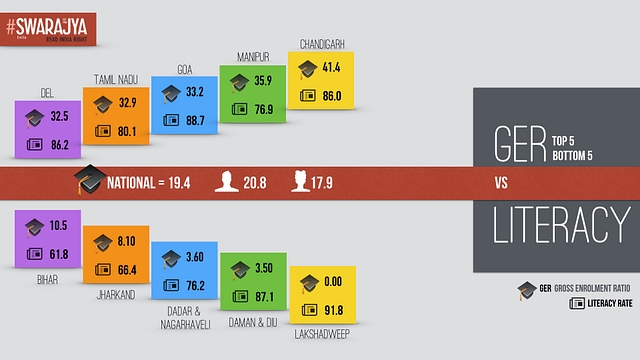
High Enough On The Educational Ladder?
How the GER stats show that not enough Indians go onto higher education.
The chart below shows the state-wise Gross Enrolment Ratio in Higher Education (GER), for the top five and bottom five states and their corresponding literacy rates, calculated during the period 2010-11. The GER here determines the number of students enrolled in school at the higher education level, expressed as a percentage of the population in the age group of 18-23 years. The national GER for higher education is 19.4; 20.8 for males and 17.9 for females. Tamil Nadu is the only ‘big-state’ present in the top five, probably owing to a large number of universities present in the state and the availability of distance-education.
States with the top five GER:
| STATES/UTs | GER | Literacy rate |
| Chandigarh | 41.4 | 86 |
| Manipur | 35.9 | 76.9 |
| Goa | 33.2 | 88.7 |
| Tamil Nadu | 32.9 | 80.1 |
| Delhi | 32.5 | 86.2 |
States with the bottom five GER:
| STATES/UTs | GER | Literacy rate |
| Bihar | 10.5 | 61.8 |
| Jharkhand | 8.1 | 66.4 |
| Dadra and Nagar Haveli | 3.6 | 76.2 |
| Daman and Diu | 3.5 | 87.1 |
| Lakshadweep | 0 | 91.8 |
The definition of literacy rate is:
The total percentage of the population of an area at a particular time aged seven years or above who can read and write with understanding.
Given the definitions of the two terms, it is obvious that the relationship between GER and literacy rate, with respect to India, is not ideal. The tables above show that in several states, though quite a lot of people are literate, they do not climb up the education ladder. Kerala, the state with the highest literacy-rate, stands 16th with a higher education GER of 21.9. Goa is the only Indian state which remains in the top five on both the scales while Bihar and Jharkhand are among the bottom on both. Chandigarh, which tops with respect to GER, stands 10th when it comes to literacy rate.
Even with a rise from 12.4% to 20% in the last decade, India lags behind in its GER when compared to the average world standards of 30%. This situation needs to be improved urgently and drastically if India needs skilled manpower for its economic aspirations and social well-being.